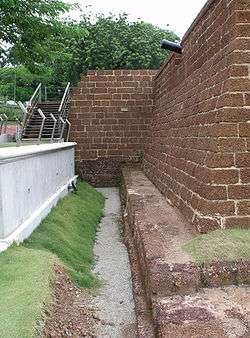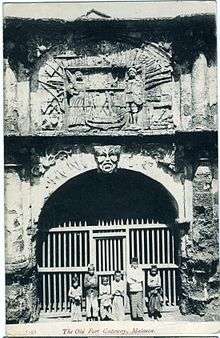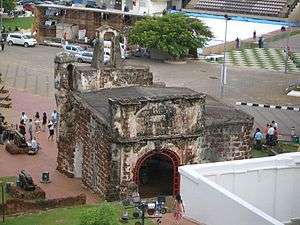A Famosa
| A Famosa | |
|---|---|
| Kota A Famosa (Malay) | |
| Malacca, Malaysia | |
|
The surviving gate of the A Famosa Portuguese fort in Malacca. | |
|
A view of the gate of the A Famosa fort from the rear. | |
| Coordinates | 2°11′29.82″N 102°15′1.10″E / 2.1916167°N 102.2503056°ECoordinates: 2°11′29.82″N 102°15′1.10″E / 2.1916167°N 102.2503056°E |
| Site information | |
| Controlled by |
Portugal (1511–1641) Netherlands (1641–1795) Britain (1795–1807) |
| Open to the public | Yes |
| Condition | Destroyed, reconstructed |
| Site history | |
| Built | 1511 |
| Built by | Portuguese Empire |
| In use | 1511–1807 |
| Demolished | 10 August 1807 (except for a small gate house) |
| Garrison information | |
| Past commanders | Afonso de Albuquerque |

A Famosa (Malay: Kota A Famosa; "The Famous" in Portuguese) is a Portuguese fortress located in Malacca, Malaysia. It is among the oldest surviving European architectural remains in south east Asia. The Porta de Santiago, a small gate house, is the only part of the fortress which still remains today.
The name is often mispronounced /eɪ/ Famosa, even among Malaysians, as though the Portuguese definite article a were the English letter A. A more authentic pronunciation would be /ɑː/ Famosa.
History

In 1511, a Portuguese fleet arrived under the command of Afonso de Albuquerque. His forces attacked and defeated the armies of the Malacca Sultanate. Moving quickly to consolidate his gains, Albuquerque had the fortress built around a natural hill near the sea. Albuquerque believed that Malacca would become an important port linking Portugal to the Spice Route in China. At this time other Portuguese were establishing outposts in such places as Macau, China and Goa, India to create a string of friendly ports for ships heading to Ming China and returning home to Portugal.
The fortress once consisted of long ramparts and four major towers. One was a four-story keep, while the others held an ammunition storage room, the residence of the captain, and an officers' quarters. Most of the village clustered in town houses inside the fortress walls. As Malacca's population expanded it outgrew the original fort and extensions were added around 1586.
The fort changed hands in 1641 when the Dutch drove the Portuguese out of Malacca.[1] The Dutch renovated the gate in 1670, which explains the logo "ANNO 1670" inscribed on the gate's arch. Above the arch is a bas-relief logo of the Dutch East India Company.
The fortress changed hands again in the late 18th century when the Dutch handed it over to the British to prevent it from falling into the hands of Napoleon's expansionist France. The English were wary of maintaining the fortification and ordered its destruction in 1806. The fort was almost totally demolished but for the timely intervention of Sir Stamford Raffles, the founder of modern Singapore, who was sent on sick leave from Penang to Malacca in 1807. Because of his passion for history, this small gate was spared from destruction.
Archaeological finding
In late November 2006, a structure part of the fort, believed to be the Bastion Middleburg was accidentally uncovered during the construction of 110 meter revolving tower in Malacca Town.[2] The construction of the tower was ceased and its site was subsequently shifted to the popular district of Bandar Hilir on Jalan Merdeka where it was officially opened to the public on 18 April 2008. Malacca Museums Corporation suspects the structure was built by the Dutch during the Dutch occupation of Malacca from 1641 to 1824.
Earlier in June 2003, a watchtower named Santiago Bastion was discovered during the construction of Dataran Pahlawan.[3]
References
- ↑ Borschberg, Peter., “Ethnicity, Language and Culture in Melaka during the Transition from Portuguese to Dutch Rule”, Journal of the Malaysian Branch of the Royal Asiatic Society, 83.2, (2010): 93-117; Borschberg, P., The Singapore and Melaka Straits: Violence, Security and Diplomacy in the 17th Century (Singapore: NUS Press, 2010).
- ↑ Lee, Cynthia. New Straits Times. Excavation for Malacca tower project unearths ruins of Dutch fort. 1 December 2006
- ↑ The Star. Old watchtower may be under site. 4 December 2006.
Notations
- De Witt, Dennis (2010). Melaka from the Top. Malaysia: Nutmeg Publishing. ISBN 978-983-43519-2-2.
External links
| Wikimedia Commons has media related to A Famosa. |
- Tourism Malaysia - St.Paul's Hill (A'Famosa)
- A Famosa at All Malaysia.info
- Description of the fort during English rules by Hikayat Abdullah.
